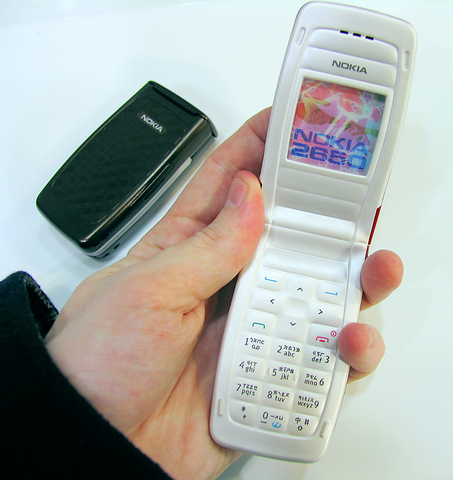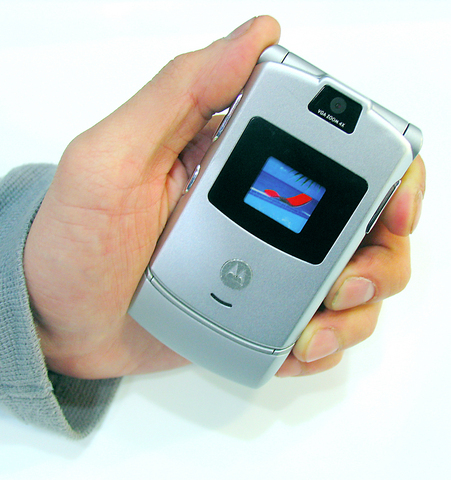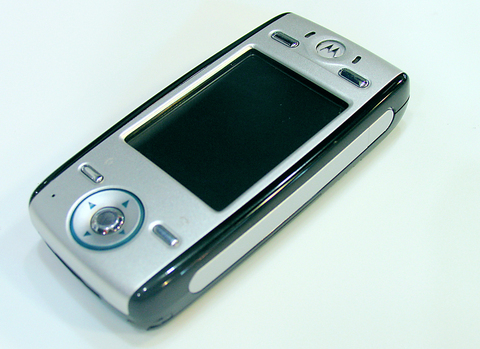Taiwan's Directorate General of Budget, Accounting and Statistics released an interesting figure in the middle of this month claiming that, of 12 countries, Taiwan led the world with the most cellular phone subscribers -- 111 per 100 people.
While the report didn't elaborate on the reasons for this seemingly implausible statistic, an informal survey of carriers suggests it has to do with the fact that many small businesses have a cellphone number as their main line to the outside world.

PHOTO: DAVID MOMPHARD, TAIPEI TIMES
"A lot of people have one number that services their business and another number for their personal cellphone," said a representative with the carrier FarEastTone.

PHOTO: DAVID MOMPHARD, TAIPEI TIMES
And though many cellphones can accommodate two lines, users are just as likely to carry two phones.
Given this, Taiwan might also lead the world in the highest number of phones per capita. Time then to take a look at some of the models clipped to local belts and tucked inside local pants' pockets. Another informal survey, this time of cellphone salespeople, suggests that the models most popular among the populace are Motorola phones.

PHOTO: DAVID MOMPHARD, TAIPEI TIMES
This is casual confirmation of the company's own claim to have nearly one half of the cellphone market in Taiwan, and it's not surprising, given the number of Motorola V505s and V600s you see people fidgeting with on buses or at bars.
The phones have been among the best-selling in Taiwan for packing in a lot of functions for business-centric users and a lot of style options for the fashion conscious.
It has to be said the "domino-effect" plays a great part in the success of these and other models. Good word of mouth moves more quickly than any other kind of review. Word of mouth is also helping to sell Motorola's latest model, the V3.
The V3 owes its design aesthetic to laptop computers, specifically Apple' s Macintosh PowerBooks. Encased in anodized aluminum, it looks much like a Mac in miniature, save that it has a screen on the front that displays a photo of whoever is calling as well as other programmable information.
Open it up to reveal its chemically-etched touchpad, which resembles nothing so much as a computer interface found on the starship Enterprise -- Next Generation, of course. Of all the models currently on the market, it probably induces the most envy.
The V3 is also getting lots of good press, not the least of which was a runner-up award from Wallpaper magazine for gadget of the year (It lost out to Apple's iPod Mini).
Design aside, the V3 has a lot of functionality as well and packs in many features you won't find in other cellphones. But at more than NT$20,000, it better. That price tag has likely kept a lot of the model's good word of mouth to a minimum.
Less expensive, albeit less enviable, is Motorola's E680. It's not a "clamshell" phone and lacks the design savvy of the V3, but it packs features on the same footing with the V3. And, as one of the better-selling smart phones in Taiwan, it presents those features more stunningly than any phone in its class.
The first thing you notice about the E680 is its large screen and lack of a type pad, leading you to think, at a glance, that it's some sort of hand-held video game. In fact, it is a hand-held video game and much more; capable of downloading Quicktime movies, carrying a virtual office, and playing MP3s.
In fact, the sound quality of the E680 is comparable to an iPod -- better considering it ships with earphones far superior to Apple's little white ear buds.
The E680 uses a stylus in lieu of a keypad, making it a two-handed phone. It' s also fairly heavy, but at NT$13,000 its price is much lighter than the V3's.
There is another model rapidly networking its way into Taiwan's cool set, according to cellphone sales clerks -- Nokia's 2650. The reason for this are simple. Clamshell-style phones have long been the preferred model among Taiwanese; Nokia has held the number two spot in Taiwan's cellphone market, and the 2650 is among the company's first clamshell offerings.
"I used to sell Motorola exclusively," said Fu Jia-wei (傅家瑋), who owns a west-side cellphone dealership, "but I began selling Nokia shortly after they began offering a line of clamshell phones. The 2650 is probably my best-seller right now."
But the reasons for the phone's popularity are also a matter of simple math: It costs just NT$4,200. At that price, and given Nokia's famed easy-to-use interface, it's destined to be the company's next workhorse model.
One last note about upgrading phones -- or buying a second model to accommodate your business phone line: If you're unhappy with your current phone because of poor reception, remember that this usually has more to do with your carrier than with the phone itself, particularly if your phone is a newer model.
In Taiwan, Chunghwa Telecom has more transmission towers than any other carrier and is often the only service that will give you a signal in remote spots of the island's interior. Climb to the top of Jade Mountain with your Chunghwa Telecom-serviced phone and you'll be popular among fellow travelers who have no reception.
For this reason, picking a good cellular service is actually the first step to picking a good cellphone. A NT$20,000 Motorola V3 with all its fancy functions becomes an anodized aluminum paperweight outside your coverage area.

The Nuremberg trials have inspired filmmakers before, from Stanley Kramer’s 1961 drama to the 2000 television miniseries with Alec Baldwin and Brian Cox. But for the latest take, Nuremberg, writer-director James Vanderbilt focuses on a lesser-known figure: The US Army psychiatrist Douglas Kelley, who after the war was assigned to supervise and evaluate captured Nazi leaders to ensure they were fit for trial (and also keep them alive). But his is a name that had been largely forgotten: He wasn’t even a character in the miniseries. Kelley, portrayed in the film by Rami Malek, was an ambitious sort who saw in

It’s always a pleasure to see something one has long advocated slowly become reality. The late August visit of a delegation to the Philippines led by Deputy Minister of Agriculture Huang Chao-ching (黃昭欽), Chair of Chinese International Economic Cooperation Association Joseph Lyu (呂桔誠) and US-Taiwan Business Council vice president, Lotta Danielsson, was yet another example of how the two nations are drawing closer together. The security threat from the People’s Republic of China (PRC), along with their complementary economies, is finally fostering growth in ties. Interestingly, officials from both sides often refer to a shared Austronesian heritage when arguing for

Among the Nazis who were prosecuted during the Nuremberg trials in 1945 and 1946 was Hitler’s second-in-command, Hermann Goring. Less widely known, though, is the involvement of the US psychiatrist Douglas Kelley, who spent more than 80 hours interviewing and assessing Goring and 21 other Nazi officials prior to the trials. As described in Jack El-Hai’s 2013 book The Nazi and the Psychiatrist, Kelley was charmed by Goring but also haunted by his own conclusion that the Nazis’ atrocities were not specific to that time and place or to those people: they could in fact happen anywhere. He was ultimately

Last week gave us the droll little comedy of People’s Republic of China’s (PRC) consul general in Osaka posting a threat on X in response to Japanese Prime Minister Sanae Takaichi saying to the Diet that a Chinese attack on Taiwan may be an “existential threat” to Japan. That would allow Japanese Self Defence Forces to respond militarily. The PRC representative then said that if a “filthy neck sticks itself in uninvited, we will cut it off without a moment’s hesitation. Are you prepared for that?” This was widely, and probably deliberately, construed as a threat to behead Takaichi, though it